Table of Contents
A patent does not provide indefinite protection. Not only is the term of a patent limited, but failure to pay the maintenance fees on the patent may also lead to the lapse of the patent. In addition, a patent may be invalidated if it appears that, at the time it was granted, the invention did not meet the conditions for patentability. Finally, the owner of a patent may renounce or revoke it at any time, in whole or in part.
Duration of the patent / Patent term
The exclusive rights resulting from the patent are valid for a fixed period of time. That is to say 20 years from the date of filing of the patent application.
In exceptional cases, a patent may also be extended, in the case of medicinal products and plant protection products, to a maximum duration of 25 years and 6 months by means of supplementary protection certificates for medicinal products and plant protection products.
Invalidation of the patent
Any interested party may apply to the court for the invalidation of a patent.
For example, if you are sued for infringement of a patent held by another person, this possibility is available to you if you consider that the patent in question should never have been granted, as it did not meet the required conditions.
A patent may only be declared invalid for the following reasons:
- the invention does not meet the conditions of patentability, i.e. the conditions of novelty, inventive step, industrial application or legality;
- the invention is not described sufficiently clearly and completely in the patent for a specialist to be able to apply it;
- the granted patent is broader than the original application for protection;
- the patent holder has no right to the invention. On this subject, see "To whom are invention and patent rights accorded?".
A partial invalidation of the patent may also be ruled on. However, the patent may not be amended by invalidation in such a way that its object extends beyond the content of the patent application as filed, or so as to extend the protection it confers under the latest version of the patent in force.
The invalidation of a patent works with retroactive effect, which means that it invalidates the patent as soon as the patent application is filed. The patent is, therefore, supposed to have never existed. However, the implementation of agreements pertaining to the patent must be respected. As long as it has to intervene before the patent invalidation and that it will not be unfair.
Please note that any invalidation by a Belgian judge of a European patent or a patent granted by the PCT route which has effects in Belgium, will only have an impact in Belgium.
Lapse
In order to maintain the patent rights, maintenance fees must be paid every year. Failing this, the patent will be lapsed.
Restoration of rights in case of non-payment of maintenance fees
It is possible to restore a lapsed patent right if it can be demonstrated that due diligence has been applied to meet the time limit for payment of a maintenance fee and that there are, therefore, exceptional circumstances for which the time limit has not been met. To this end, the patent holder must submit an application for restoration of the rights in accordance with the conditions of the general restoration procedure (including payment of a restoration fee).
However, this restoration will have no effect on the rights of use of the invention acquired in the meantime by third parties.
Surrender
The patent holder may surrender his patent or patent application at any time. To this end, they must send a written and signed request to the Minister for the Economy. This may be a total or partial surrender, limited to one or more claims or a part of a claim.
The surrender does not have retroactive effect and will, therefore, result in the lapse of the patent or patent application on the date on which the request for surrender is entered in the register. In the case of a total surrender of a patent, this will only take effect at the end of the period covered by the most recent paid maintenance fee.
Here again, it is advisable to keep in mind that the patent may not be amended by renunciation in such a way that its object extends beyond the content of the application as filed, or so as to extend the protection it confers under the latest version of the patent in force.
Revocation
The patent holder may revoke his patent or patent application at any time. To this end, he must send a written and signed request to the Minister for the Economy. This may be a total revocation or a partial revocation in the form of an amendment to the claims and, where applicable, the description or drawings.
The revocation is entered in the register and has retroactive effect until the time of the application. If the revocation is made during the course of legal proceedings relating to the patent, the owner must first file the declaration with the Office. The patent thus amended serves as the basis for legal procedure.
Here again, it is advisable to keep in mind that the patent may not be amended by revocation in such a way that its object extends beyond the content of the patent application as filed, or so as to extend the protection it confers under the latest version of the patent in force.
Lack of use
The patent holder has an obligation to use his invention. If not, he runs the risk that compulsory licences due to lack of use may be granted to third parties for the invention.


